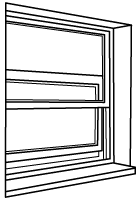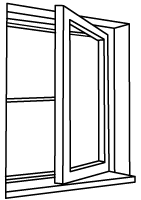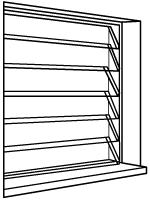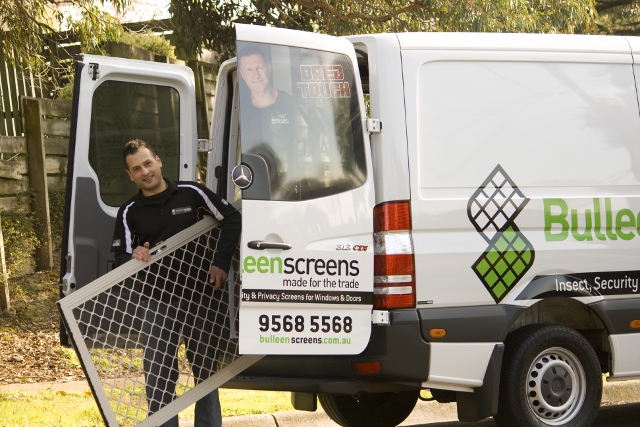Fitting a flyscreen to windows:
- Aluminium Flyscreens are for attaching to the inside or outside of a window to reduce the size of gaps that insects can get through when the window is open
- Every screen, for every window must be measured individually because even a 2mm difference (which often occurs in ‘identical’ windows) makes the world of difference to whether you believe the screen will work effectively or even stay on the window or not.
Sliding windows

- Typically a screen will fit inside a channel in the opening ‘sash’ (sash is the moving part of a window) on the outside of the building, so that you can operate the window from inside without touching the screen.
- The methods used to make the screen go into and out of the channels are many and varied. Our team have vast experience, but they still regularly see windows they’ve never seen before and need to use their judgement to formulate a size that is big enough to work, but small enough to fit in. This is a tricky task that takes skill and experience to get the best result, but is not necessarily beyond the amateur handyperson.
Awning windows (hinged at the top)

- The screen must fit somewhere on the inside of the window so it can seal when the sash is open. (Positioning of blinds within the window frame ‘reavea’ is an issue for fitting & removing screens)
- Modern windows usually have a winder mechanism in the middle of the inside sill that will open the sash. Our screen needs to sit over this winder. In some cases, the gaps beside the winder will have already been filled in, but in others, we need to fit a “Tail Piece” which is then cut over the winder.
- Most modern winders are typically a generic size, so our standard “Tail Piece” has a pre-scored line we can cut up to for a good fit.

This is the process of cutting a tail piece to go over a winder
Pair of tin snips, a screen with an uncut tail piece and the winder.

Remove the tailpiece from the screen;
Offer the tailpiece back to the winder in the window frame and mark where you want the cuts with a pencil;
Cut using tin snips and snap off using pliers, by bending back and forth along the score in the metal.

Refit the tailpiece to the screen.

Fit the completed screen over the winder.

Double-Hung Window (two sashes moving up and down)

- Typically the screen will fit on the outside of the building so that you can operate the window from inside without moving the screen. Sometimes this necessitates a ladder or scaffold to measure and install, but sometimes, we can fit upstairs windows to the outside of the house from the inside.
- On some older timber windows, generations of paint have locked one or both sashes shut. The best ventilation occurs when both top & bottom are open (hot air out the top, cool air in below), but when we encounter old windows, where people have unstuck only the bottom one, we often fit small channels beside the lower sash and slide the ½ size screen into these. The channels help hide gaps created by old, out of square, window frames, ensuring a good seal.

- When we fit a full-sized screen over both sashes, it will depend on the construction of the window frame about whether we ‘face fit’ (the back of the screen seals against the frame) or fit within the opening (the sides provide the seal).
- Ideally, if we fit within the opening, we want a ‘stop’ or ridge, or some other surface that is slightly smaller than the outer edge of the screen to rest against and provide the seal, otherwise even the tiniest gaps will look enormous and you’ll think the screen won’t work.

Casement Window (hinged on one side, usually opening out)

- The screen must fit on the opposite side to where the glass is moving (usually fitted inside, for glass moving outside).
- Most times, these are a difficult window to screen because unlike an awning, they usually aren’t operated by a winder, so must be manually opened. Therefore, (most commonly, for outward opening windows)
- The screen needs to move out of the way to allow opening and closing to occur.
- Further to this, a lot of older windows have a metal handle to operate the sash and this will sit in a position where, unless you remove it entirely, will not allow the fitting of a screen at all.
- Some window manufacturers have realised this difficulty (for example Dowell) and have designed their casements to be able to be manually opened without moving the screen.
- Where we need to create a moving screen, we often use hinges or recommend a soft-framed magnetic screen in this application. The magnetic screens are great in this application, but are typically 3 of 4 times the price of one of our basic aluminium framed screens of the same size.

This shows a clear plastic hinge with the screw exposed at the corner of the screen.
Louvre Windows

- The screen is usually fitted on the outside, so that the louvers may be operated from the inside.
- The issue with fitting screens is whether the blades protrude beyond the obvious mounting point for the screen when fully opened. If they do, then we need to customise a mounting solution (which usually becomes unsightly) or, you need to accept that the blades won’t fully open.
Sashless Windows

- These windows have either an aluminium or timber outer frame, but the glass itself is not framed. They may be vertical windows as shown, or slide horizontally.
- Typically, we will fit screens to the outside of these windows.
- We need to be careful where and how we mount and attach screens to these windows to ensure we don’t jam the counter-weight mechanisms.

















